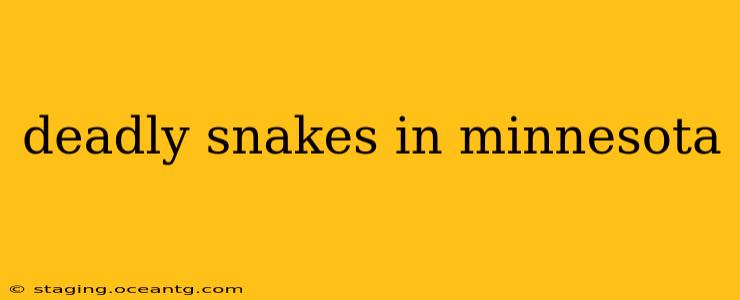Minnesota's reputation is far from that of a snake-infested wilderness. While the state boasts a diverse reptile population, the idea of "deadly snakes" conjures images often far removed from reality. This article will explore the venomous snakes found in Minnesota, debunking common myths and providing crucial information for safe co-existence.
It's crucial to understand that while venomous snakes do exist in Minnesota, encounters are relatively rare, and serious bites are even rarer still. Responsible behavior and a healthy respect for wildlife are far more effective than fear in ensuring safety.
What venomous snakes are found in Minnesota?
The only venomous snake native to Minnesota is the Massasauga rattlesnake ( Sistrurus catenatus ). This small rattlesnake is easily identifiable by its characteristic rattle and relatively stout body. They are generally shy and prefer to avoid confrontation, using their rattle as a warning before striking. Their venom is medically significant, requiring immediate medical attention if bitten.
It's important to note that there are no other venomous snakes naturally occurring within Minnesota's borders. Claims of copperheads, cottonmouths, or other venomous species being present are typically inaccurate.
Are there other potentially dangerous snakes in Minnesota?
While the Massasauga is the only venomous species, other snakes in Minnesota could cause concern, although not through venom:
- Northern Watersnake (Nerodia sipedon): Often mistaken for venomous cottonmouths due to their similar appearance, Northern Watersnakes are non-venomous and harmless to humans. Their defensive behaviors might involve hissing or striking, but they rarely bite.
- Garter Snakes (Thamnophis sirtalis): These are extremely common and generally harmless. They are often seen near water and are adept swimmers. Although they can bite, their bites are not dangerous.
While these snakes are not dangerous, it's always wise to observe them from a distance and avoid handling them.
How common are Massasauga rattlesnake bites in Minnesota?
Massasauga rattlesnake bites are exceptionally rare in Minnesota. The snake is a shy creature that prefers to avoid humans. Most bites occur when people intentionally or unintentionally provoke the snake. The snake's habitat is also often remote, further reducing the likelihood of human encounters.
What should I do if I see a Massasauga rattlesnake?
If you encounter a Massasauga rattlesnake, the best course of action is to leave it alone. Give the snake plenty of space to move away, and avoid making any sudden movements. Observe it from a safe distance, and appreciate it as a part of Minnesota's natural ecosystem. Do not attempt to handle or kill it.
What should I do if I am bitten by a snake in Minnesota?
If you are bitten by a snake in Minnesota, seek immediate medical attention. While most snakebites in the state are not venomous, it is crucial to get a professional assessment. Try to remember the snake's characteristics (size, color, pattern) to help medical professionals identify the culprit and determine the appropriate treatment.
How can I avoid snake bites in Minnesota?
Avoiding snake bites is primarily about respecting their habitat and practicing caution:
- Be aware of your surroundings: When hiking or camping, pay attention to where you are placing your hands and feet.
- Wear appropriate footwear: Sturdy boots or shoes can offer protection from snake bites.
- Avoid areas known to harbor snakes: Stay away from areas like rocky outcrops, tall grasses, and brush piles, particularly during warm weather.
- Never attempt to handle snakes: Appreciate them from a distance, and leave them to their natural environment.
By understanding the snakes of Minnesota and adopting responsible behavior, you can safely enjoy the state's natural beauty while coexisting peacefully with its reptilian inhabitants. Remember, fear is often unfounded; knowledge and respect are the best defenses.
